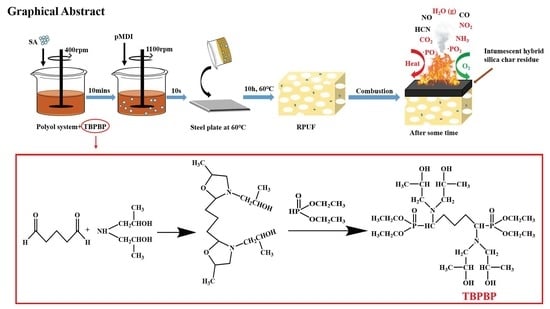Enhancing the Fire Safety and Smoke Safety of Bio–Based Rigid Polyurethane Foam via Inserting a Reactive Flame Retardant Containing P@N and Blending Silica Aerogel Powder
Abstract
:1. Introduction
2. Materials and Methods
2.1. Raw Materials
2.2. Preparation of Tetraethyl (1,5–bis(bis(2–hydroxypropyl)amino)pentane–1,5 –diyl)bis(phosphonate) (TBPBP)
2.3. Preparation of Castor Oil–Based Rigid Polyurethane Foams
2.4. Characterization
3. Results and Discussion
3.1. Characterization of TBPBP
3.2. Characterization of RPUFs
3.2.1. Chemical Component
3.2.2. Surface Microstructure, Mapping Energy Spectrum Analyses
3.2.3. Physical and Mechanical Properties
3.2.4. Thermal Stability
3.2.5. Flame Behavior
3.2.6. Surface Microstructure, Mapping Energy Spectrum Analyses of Char Residues
3.2.7. Raman Tests for Char Residues
3.2.8. Cone Calorimeter Testing
3.2.9. Py–GC/MS Analysis of RPUF–T45 and FI–IR Analysis of Its Residue
3.3. Possible Flame–Retardant Mechanism
4. Conclusions
Supplementary Materials
Author Contributions
Funding
Institutional Review Board Statement
Informed Consent Statement
Data Availability Statement
Conflicts of Interest
References
- Kirpluks, M.; Kalnbunde, D.; Benes, H.; Cabulis, U. Natural oil based highly functional polyols as feedstock for rigid polyurethane foam thermal insulation. Ind. Crop. Prod. 2018, 122, 627–636. [Google Scholar] [CrossRef]
- Günther, M.; Lorenzetti, A.; Schartel, B. Fire Phenomena of Rigid Polyurethane Foams. Polymers 2018, 10, 1166. [Google Scholar] [CrossRef] [Green Version]
- Mahmood, N.; Yuan, Z.; Schmidt, J.; Xu, C.C. Depolymerization of lignins and their applications for the preparation of polyols and rigid polyurethane foams: A review. Renew. Sustain. Energy Rev. 2016, 60, 317–329. [Google Scholar] [CrossRef]
- Singh, H.; Jain, A.K. Ignition, combustion, toxicity, and fire retardancy of polyurethane foams: A comprehensive review. J. Appl. Polym. Sci. 2008, 111, 1115–1143. [Google Scholar] [CrossRef]
- Engels, H.; Pirkl, H.; Albers, R.; Albach, R.W.; Krause, J.; Hoffmann, A.; Casselmann, H.; Dormish, J. Polyurethanes: Versatile Materials and Sustainable Problem Solvers for Today’s Challenges. Angew. Chem. Int. Ed. 2013, 52, 9422–9441. [Google Scholar] [CrossRef] [PubMed]
- Xi, W.; Qian, L.; Chen, Y.; Wang, J.; Liu, X. Addition flame–retardant behaviors of expandable graphite and [bis(2–hydroxyethyl)amino]–methyl–phosphonic acid dimethyl ester in rigid polyurethane foams. Polym. Degrad. Stabil. 2015, 122, 36–43. [Google Scholar] [CrossRef]
- Wang, S.; Zhao, H.; Rao, W.; Huang, S.; Wang, T.; Liao, W.; Wang, Y. Inherently flame–retardant rigid polyurethane foams with excellent thermal insulation and mechanical properties. Polymer 2018, 153, 616–625. [Google Scholar] [CrossRef]
- Chattopadhyay, D.K.; Webster, D.C. Thermal stability and flame retardancy of polyurethanes. Prog. Polym. Sci. 2009, 34, 1068–1133. [Google Scholar] [CrossRef]
- Cao, Z.; Liao, W.; Wang, S.; Zhao, H.; Wang, Y. Polyurethane foams with functionalized graphene towards high fire–resistance, low smoke release, superior thermal insulation. Chem. Eng. J. 2019, 361, 1245–1254. [Google Scholar] [CrossRef]
- Chen, Y.; Li, L.; Qi, X.; Qian, L. The pyrolysis behaviors of phosphorus–containing organosilicon compound modified APP with different polyether segments and their flame retardant mechanism in polyurethane foam. Compos. Part B Eng. 2019, 173, 106784. [Google Scholar] [CrossRef]
- Yang, H.; Liu, H.; Jiang, Y.; Chen, M.; Wan, C. Density Effect on Flame Retardancy, Thermal Degradation, and Combustibility of Rigid Polyurethane Foam Modified by Expandable Graphite or Ammonium Polyphosphate. Polymers 2019, 11, 668. [Google Scholar] [CrossRef] [Green Version]
- Li, M.; Wang, S.; Han, L.; Yuan, W.; Cheng, J.; Zhang, A.; Zhao, H.; Wang, Y. Hierarchically porous SiO2/polyurethane foam composites towards excellent thermal insulating, flame–retardant and smoke–suppressant performances. J. Hazard. Mater. 2019, 375, 61–69. [Google Scholar] [CrossRef] [PubMed]
- Lu, W.; Ye, J.; Zhu, L.; Jin, Z.; Matsumoto, Y. Intumescent Flame Retardant Mechanism of Lignosulfonate as a Char Forming Agent in Rigid Polyurethane Foam. Polymers 2021, 13, 1585. [Google Scholar] [CrossRef]
- Zhou, W.; Hao, S.; Feng, G.; Jia, P.; Ren, X.; Zhang, M.; Zhou, Y. Properties of Rigid Polyurethane Foam Modified by Tung Oil–Based Polyol and Flame–Retardant Particles. Polymers 2020, 12, 119. [Google Scholar] [CrossRef] [Green Version]
- Bo, G.; Xu, X.; Tian, X.; Wu, J.; He, X.; Xu, L.; Yan, Y. Enhancing the flame retardancy for castor oil–based rigid polyurethane foams via silica aerogel. J. Non–Cryst. Solids. 2021, 562, 120783. [Google Scholar] [CrossRef]
- Rao, W.; Xu, H.; Xu, Y.; Qi, M.; Liao, W.; Xu, S.; Wang, Y. Persistently flame–retardant flexible polyurethane foams by a novel phosphorus–containing polyol. Chem. Eng. J. 2018, 343, 198–206. [Google Scholar] [CrossRef]
- Paciorek–Sadowska, J.; Borowicz, M.; Czupryński, B.; Tomaszewska, E.; Liszkowska, J. Oenothera biennis seed oil as an alternative raw material for production of bio–polyol for rigid polyurethane–polyisocyanurate foams. Ind. Crop. Prod. 2018, 126, 208–217. [Google Scholar] [CrossRef]
- Zhang, X.; Kim, Y.; Elsayed, I.; Taylor, M.; Eberhardt, T.L.; Hassan, E.B.; Shmulsky, R. Rigid polyurethane foams containing lignin oxyalkylated with ethylene carbonate and polyethylene glycol. Ind. Crop. Prod. 2019, 141, 111797. [Google Scholar] [CrossRef]
- Rao, W.; Shi, J.; Yu, C.; Zhao, H.; Wang, Y. Highly efficient, transparent, and environment–friendly flame–retardant coating for cotton fabric. Chem. Eng. J. 2021, 424, 130556. [Google Scholar] [CrossRef]
- Thirumal, M.; Khastgir, D.; Nando, G.B.; Naik, Y.P.; Singha, N.K. Halogen–free flame retardant PUF: Effect of melamine compounds on mechanical, thermal and flame retardant properties. Polym. Degrad. Stabil. 2010, 95, 1138–1145. [Google Scholar] [CrossRef]
- Hebda, E.; Bukowczan, A.; Michałowski, S.; Wroński, S.; Urbaniak, P.; Kaczmarek, M.; Hutnik, E.; Romaniuk, A.; Wolun–Cholewa, M.; Pielichowski, K. Examining the influence of functionalized POSS on the structure and bioactivity of flexible polyurethane foams. Mater. Sci. Eng. C. 2020, 108, 110370. [Google Scholar] [CrossRef]
- Gama, N.; Costa, L.C.; Amaral, V.; Ferreira, A.; Barros–Timmons, A. Insights into the physical properties of biobased polyurethane/expanded graphite composite foams. Compos. Sci. Technol. 2017, 138, 24–31. [Google Scholar] [CrossRef]
- Rodríguez–Pérez, M.A.; Alonso, O.; Souto, J.; de Saja, J.A. Thermal conductivity of physically crosslinked closed cell polyolefin foams. Polym. Test. 1997, 16, 287–298. [Google Scholar] [CrossRef]
- Septevani, A.A.; Evans, D.A.C.; Annamalai, P.K.; Martin, D.J. The use of cellulose nanocrystals to enhance the thermal insulation properties and sustainability of rigid polyurethane foam. Ind. Crop. Prod. 2017, 107, 114–121. [Google Scholar] [CrossRef]
- Członka, S.; Strąkowska, A.; Strzelec, K.; Kairytė, A.; Kremensas, A. Melamine, silica, and ionic liquid as a novel flame retardant for rigid polyurethane foams with enhanced flame retardancy and mechanical properties. Polym. Test. 2020, 87, 106511. [Google Scholar] [CrossRef]
- Choe, H.; Choi, Y.; Kim, J.H. Threshold cell diameter for high thermal insulation of water–blown rigid polyurethane foams. J. Ind. Eng. Chem. 2019, 73, 344–350. [Google Scholar] [CrossRef]
- Acuña, P.; Li, Z.; Santiago–Calvo, M.; Villafañe, F.; Rodríguez–Perez, M.; Wang, D. Influence of the Characteristics of Expandable Graphite on the Morphology, Thermal Properties, Fire Behaviour and Compression Performance of a Rigid Polyurethane Foam. Polymers 2019, 11, 168. [Google Scholar] [CrossRef] [PubMed] [Green Version]
- Levchik, S.V.; Weil, E.D. Thermal decomposition, combustion and fire–retardancy of polyurethanes—a review of the recent literature. Polym. Int. 2004, 53, 1585–1610. [Google Scholar] [CrossRef]
- Zhao, P.; Rao, W.; Luo, H.; Wang, L.; Liu, Y.; Yu, C. Novel organophosphorus compound with amine groups towards self–extinguishing epoxy resins at low loading. Mater. Design. 2020, 193, 108838. [Google Scholar] [CrossRef]
- Borowicz, M.; Paciorek–Sadowska, J.; Lubczak, J.; Czupryński, B. Biodegradable, Flame–Retardant, and Bio–Based Rigid Polyurethane/Polyisocyanurate Foams for Thermal Insulation Application. Polymers 2019, 11, 1816. [Google Scholar] [CrossRef] [Green Version]
- Han, S.; Zhu, X.; Chen, F.; Chen, S.; Liu, H. Flame–retardant system for rigid polyurethane foams based on diethyl bis(2–hydroxyethyl)aminomethylphosphonate and in–situ exfoliated clay. Polym. Degrad. Stabil. 2020, 177, 109178. [Google Scholar] [CrossRef]
- Modesti, M.; Lorenzetti, A.; Besco, S.; Hrelja, D.; Semenzato, S.; Bertani, R.; Michelin, R.A. Synergism between flame retardant and modified layered silicate on thermal stability and fire behaviour of polyurethane nanocomposite foams. Polym. Degrad. Stabil. 2008, 93, 2166–2171. [Google Scholar] [CrossRef]
- Lorenzetti, A.; Dittrich, B.; Schartel, B.; Roso, M.; Modesti, M. Expandable graphite in polyurethane foams: The effect of expansion volume and intercalants on flame retardancy. J. Appl. Polym. Sci. 2017, 134, 45173. [Google Scholar] [CrossRef]
- Qian, L.; Feng, F.; Tang, S. Bi–phase flame–retardant effect of hexa–phenoxy–cyclotriphosphazene on rigid polyurethane foams containing expandable graphite. Polymer 2014, 55, 95–101. [Google Scholar] [CrossRef]
- Wang, H.; Li, S.; Zhu, Z.; Yin, X.; Wang, L.; Weng, Y.; Wang, X. A novel DOPO–based flame retardant containing benzimidazolone structure with high charring ability towards low flammability and smoke epoxy resins. Polym. Degrad. Stabil. 2021, 183, 109426. [Google Scholar] [CrossRef]
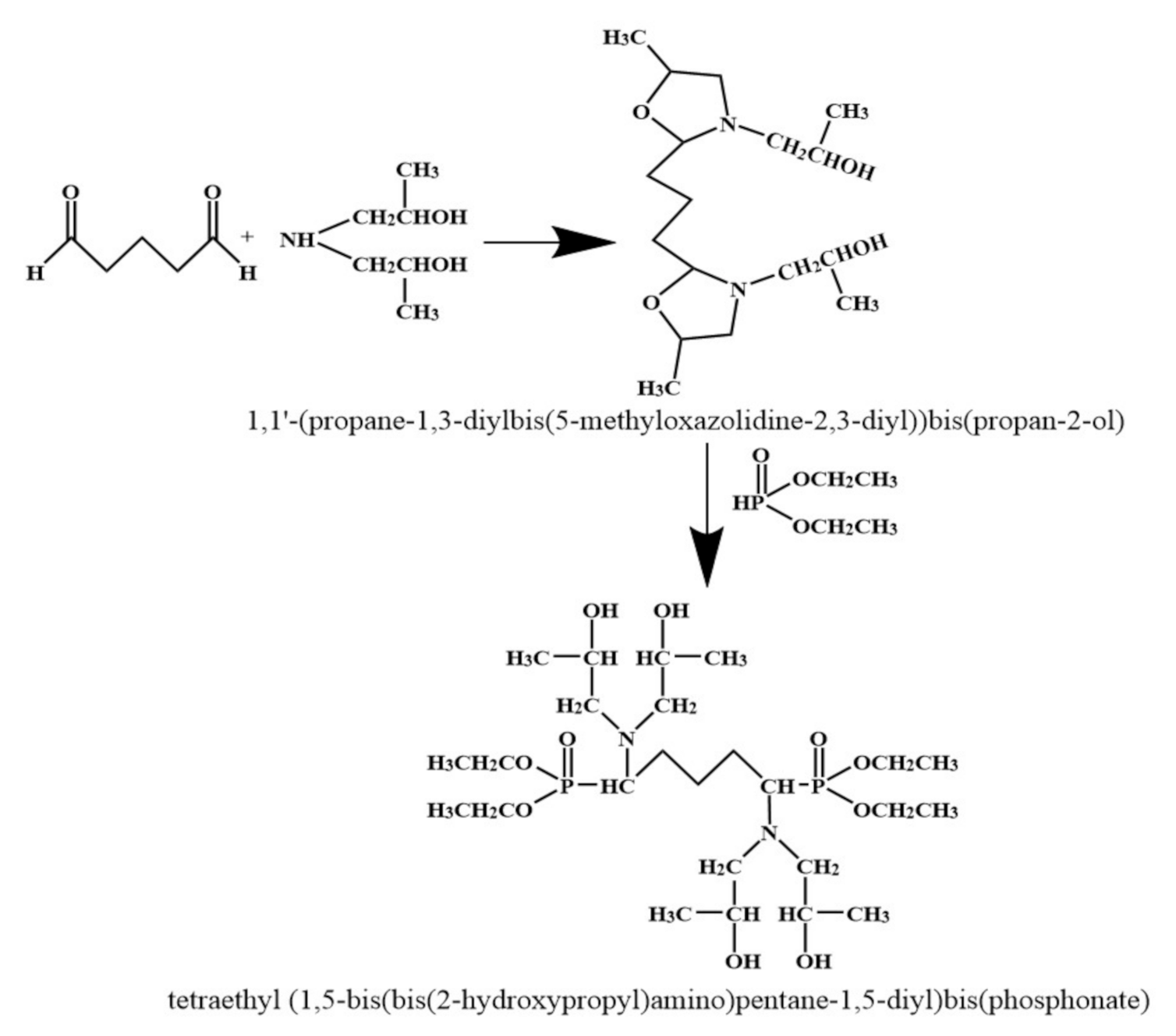
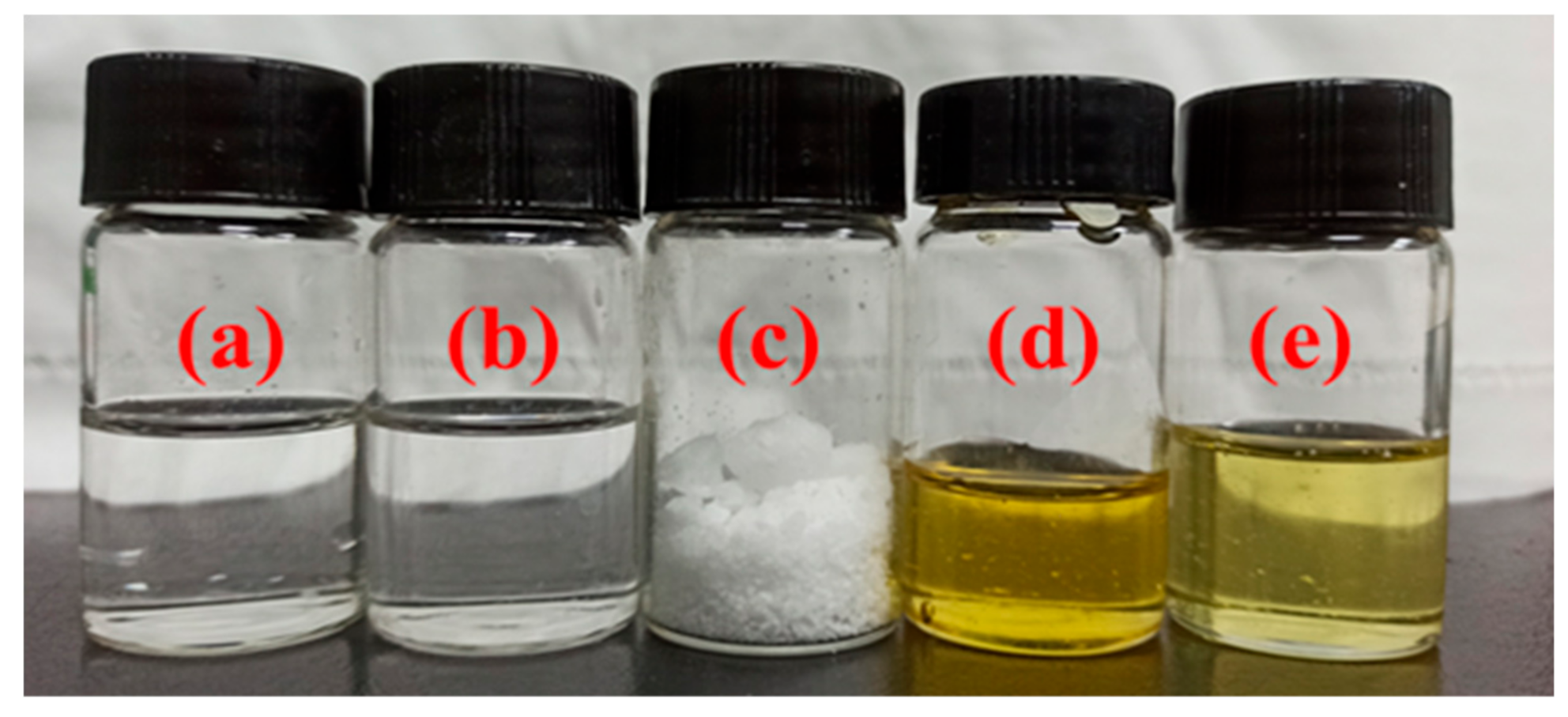

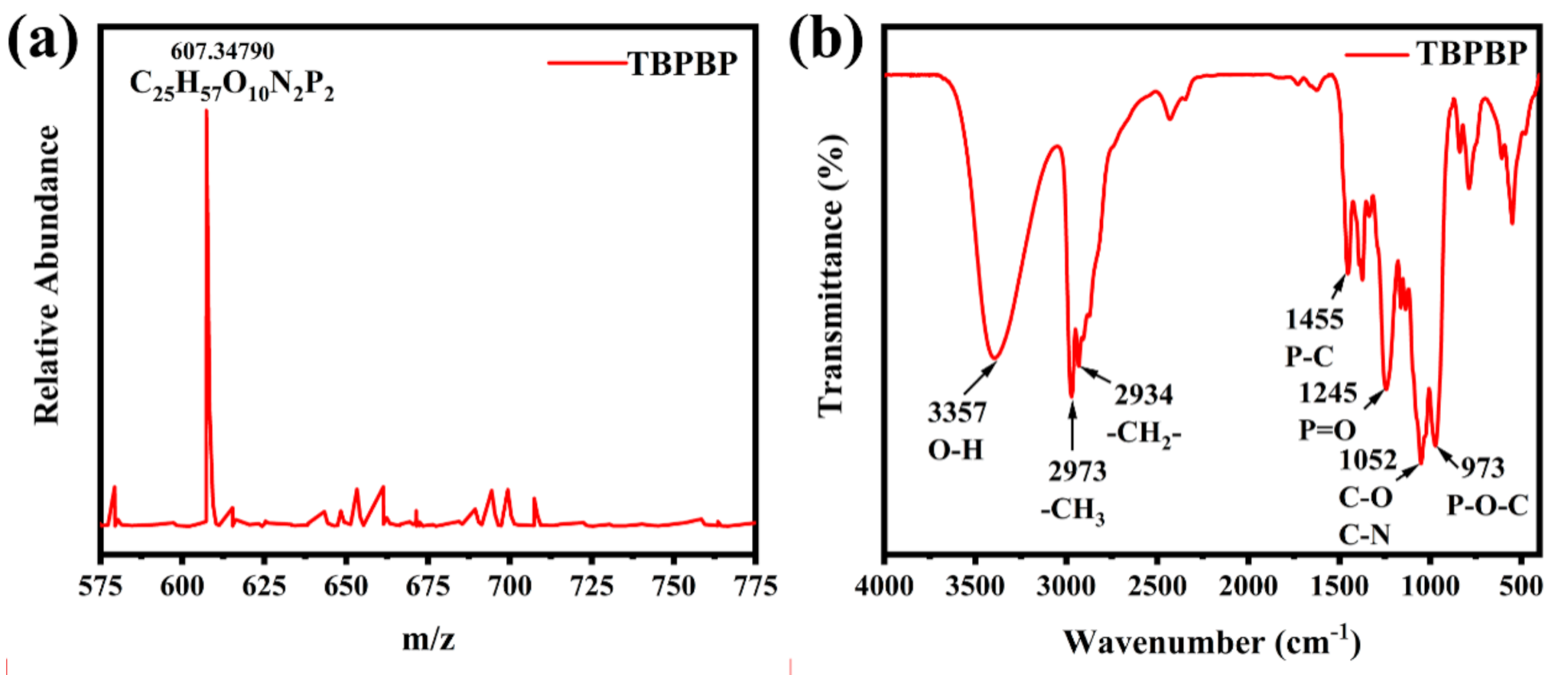
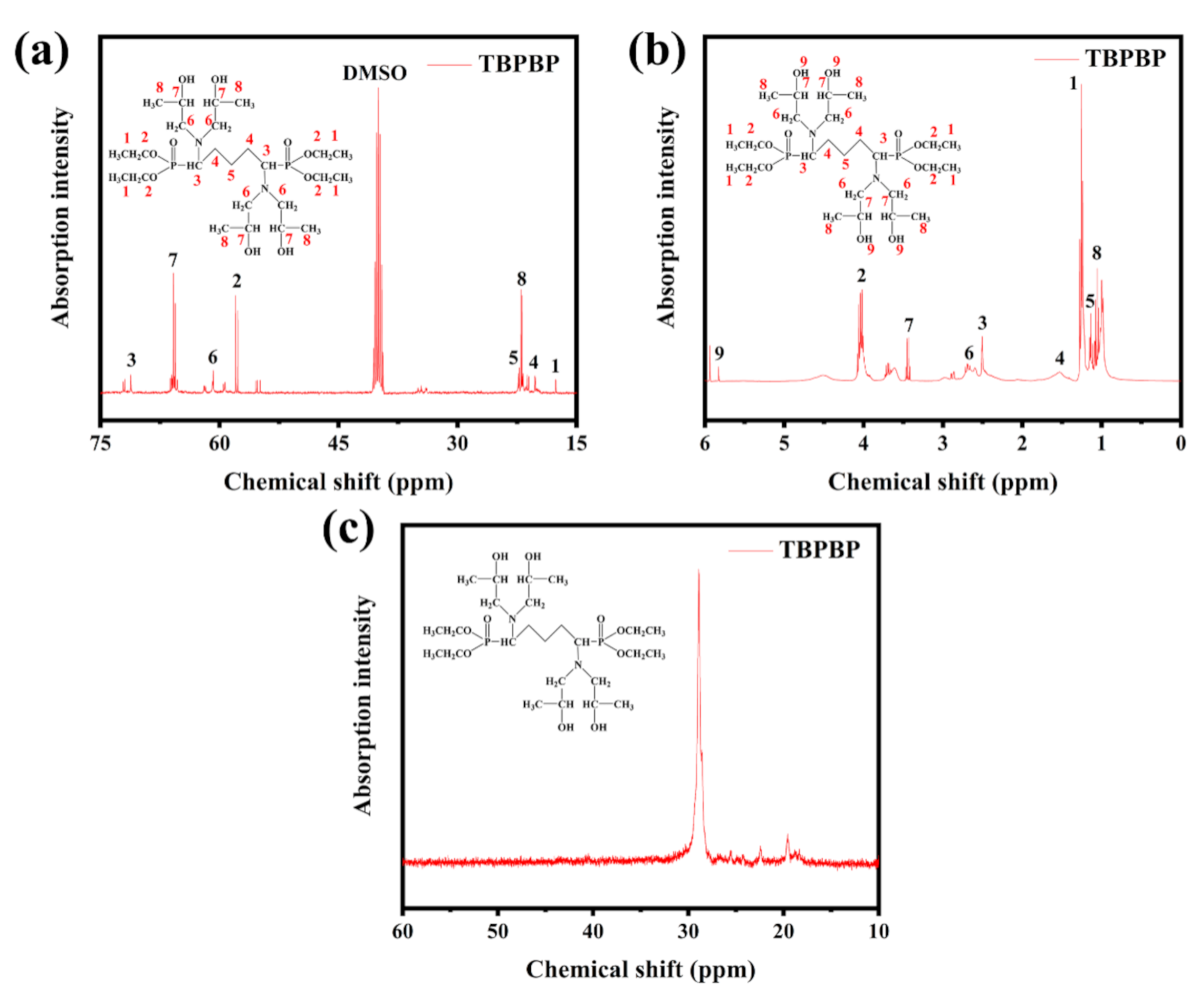
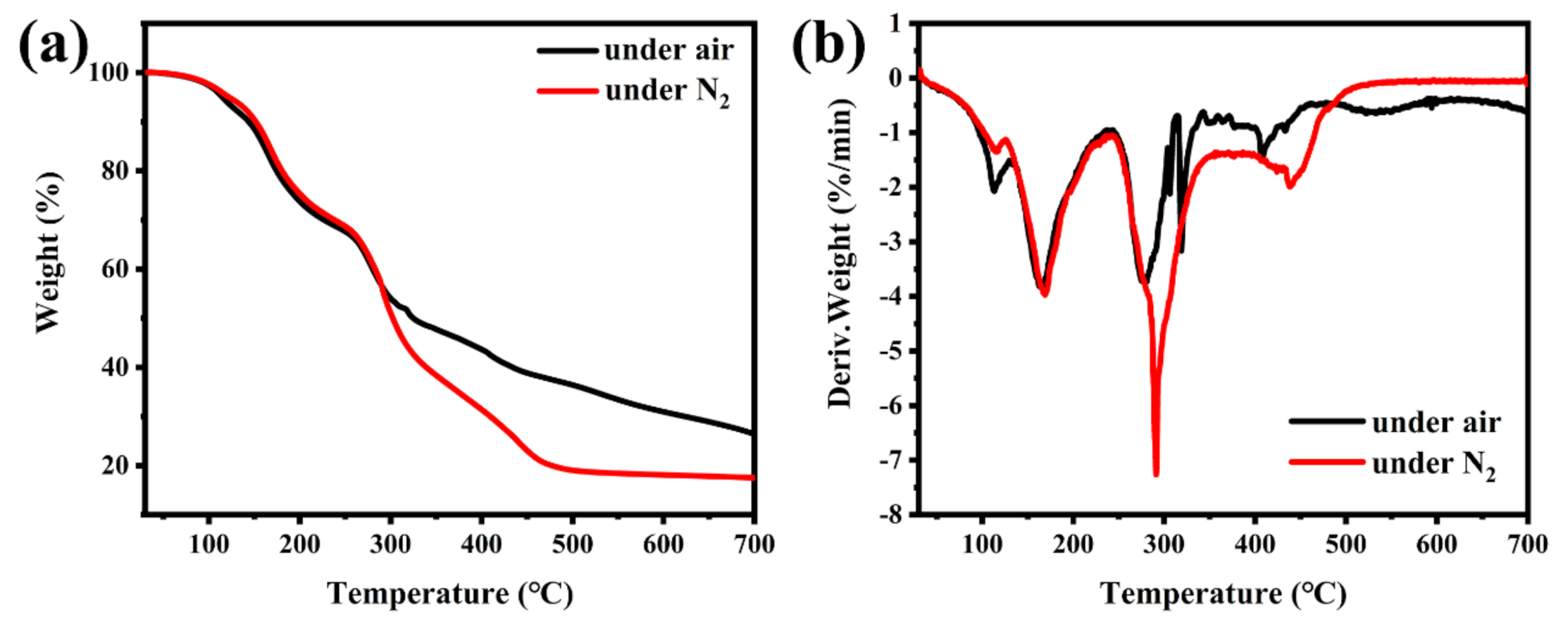


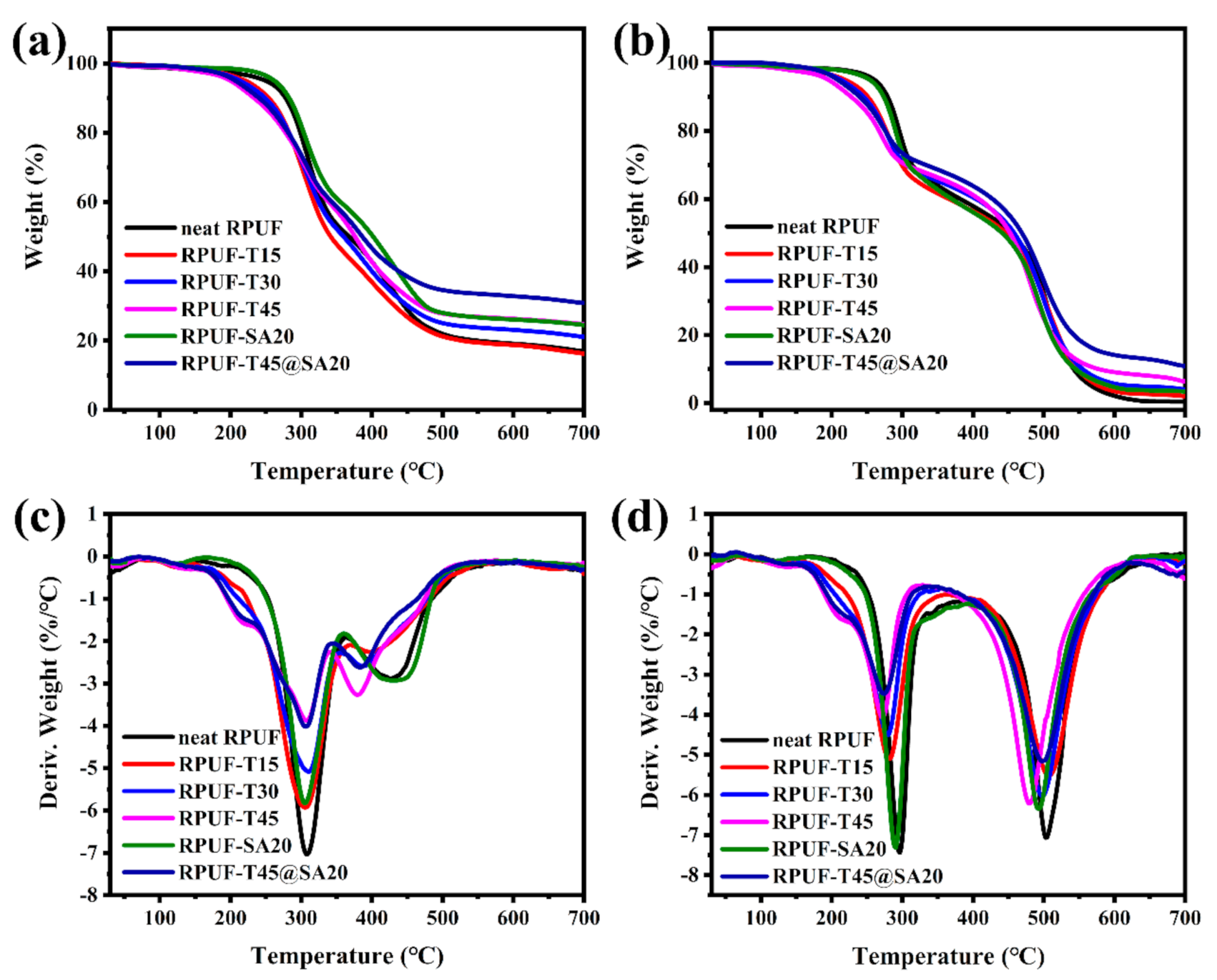
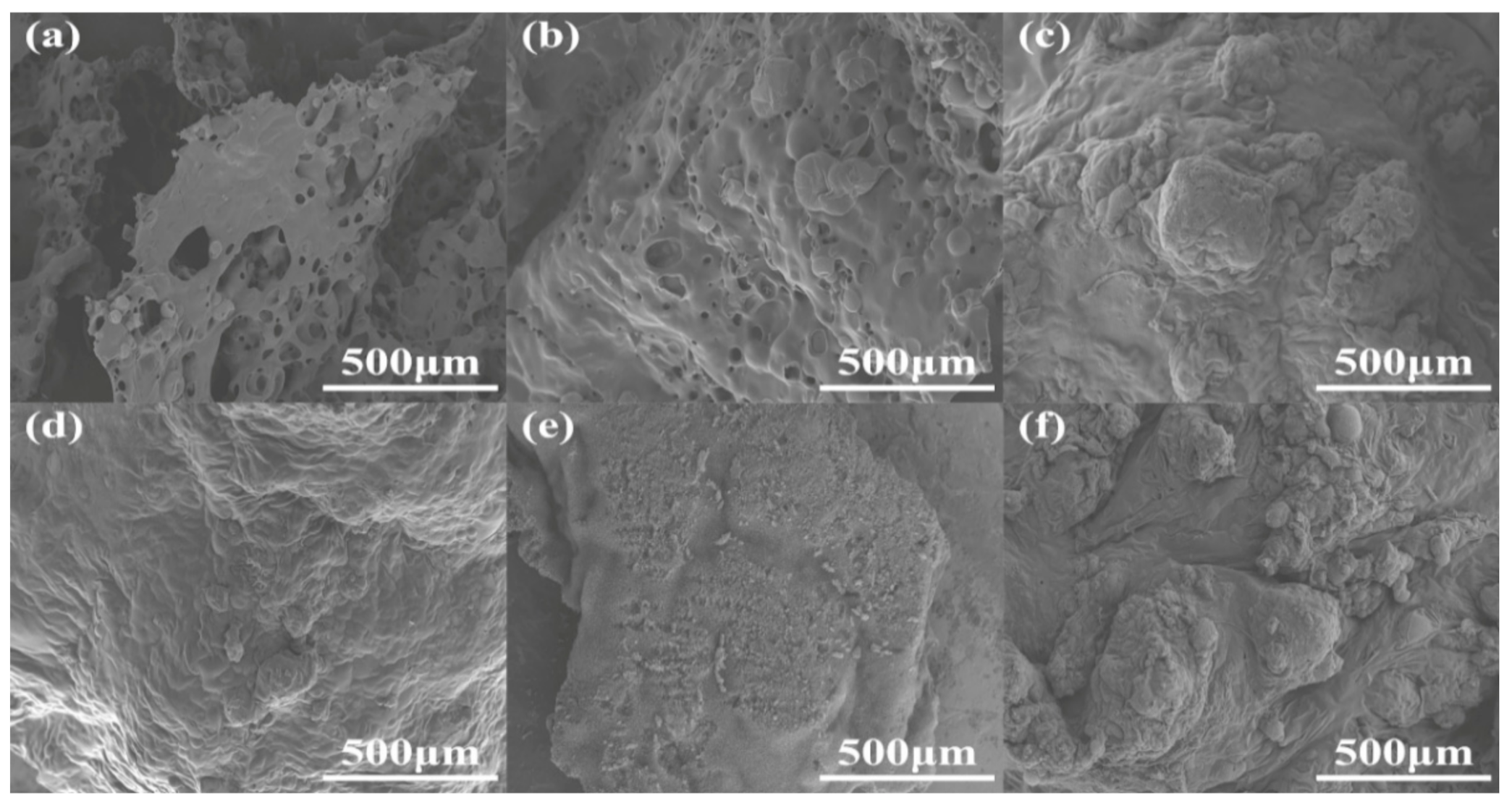

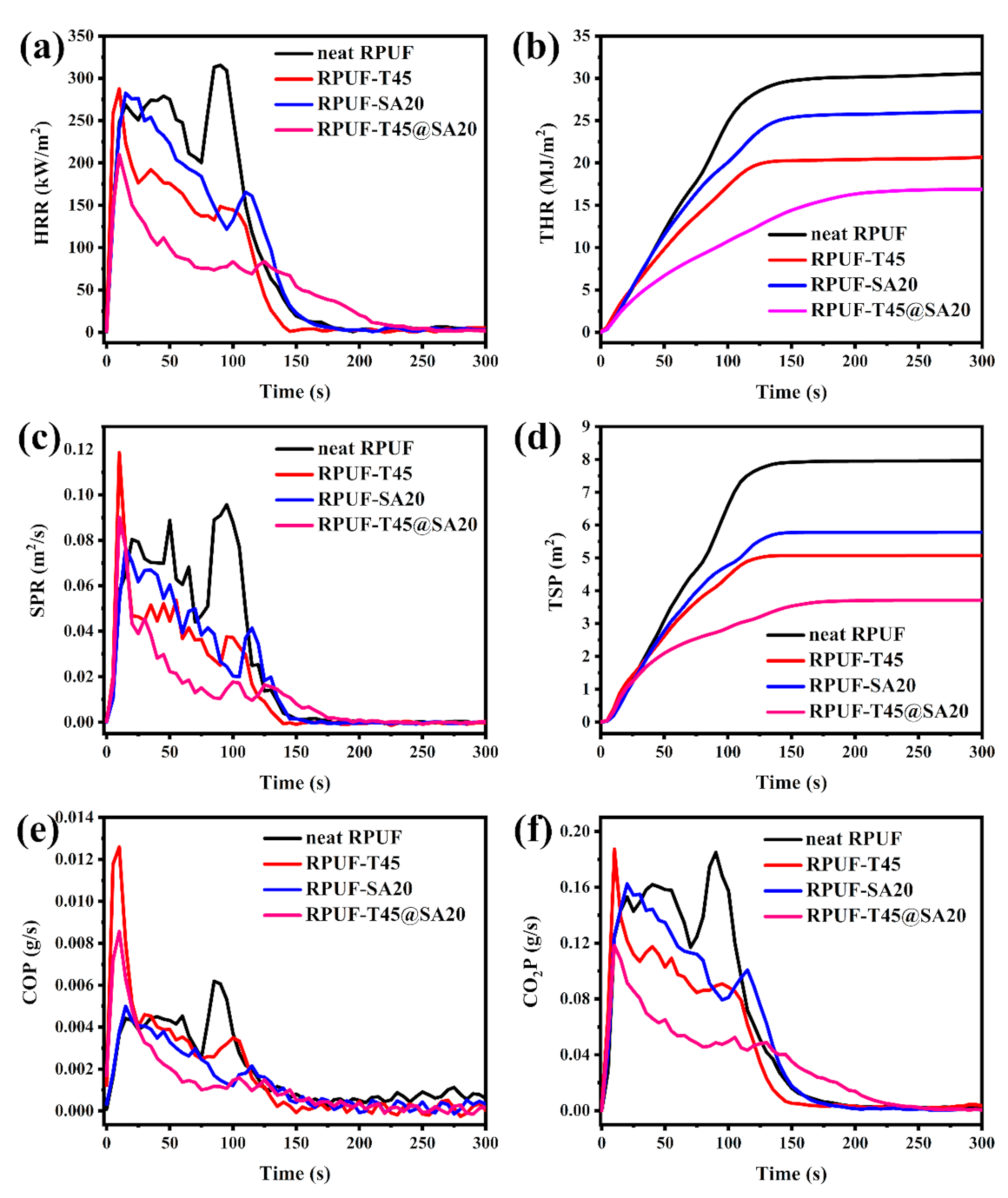

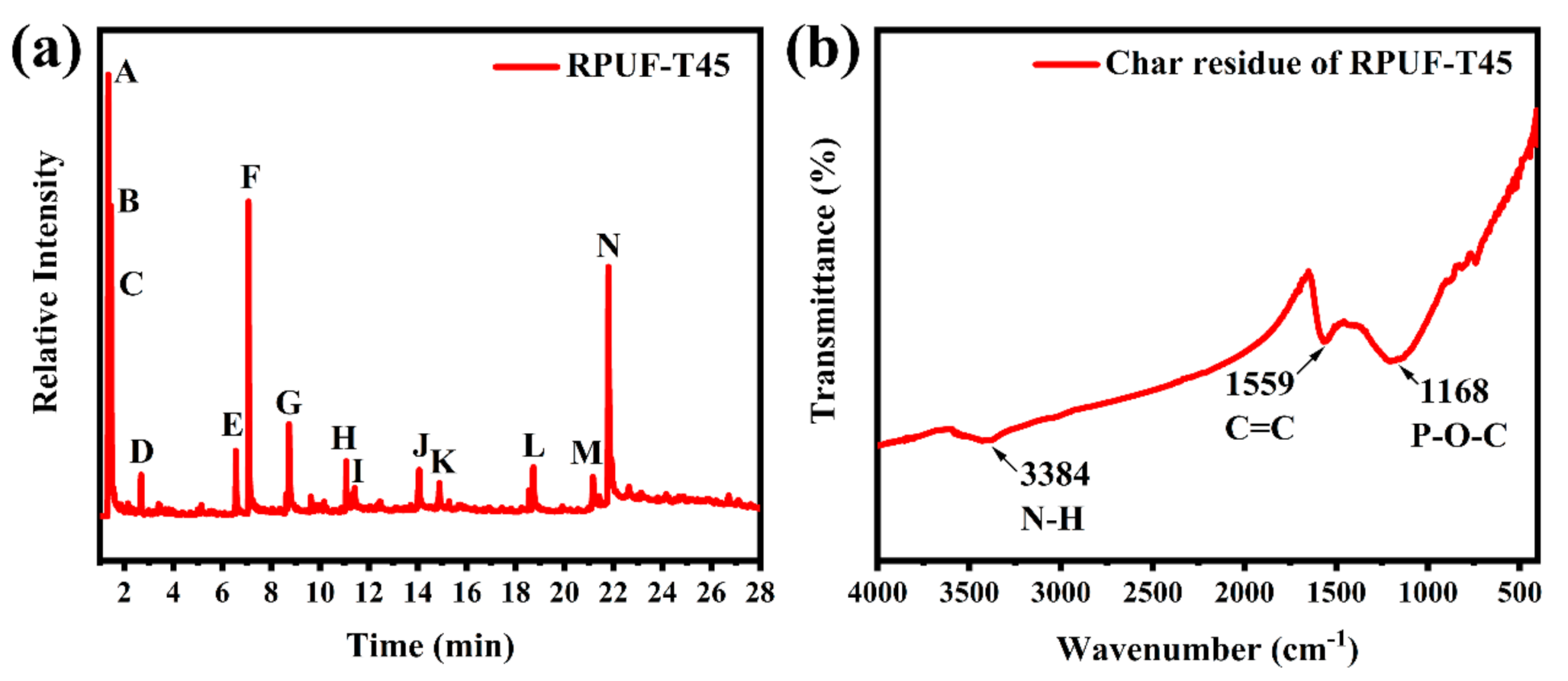
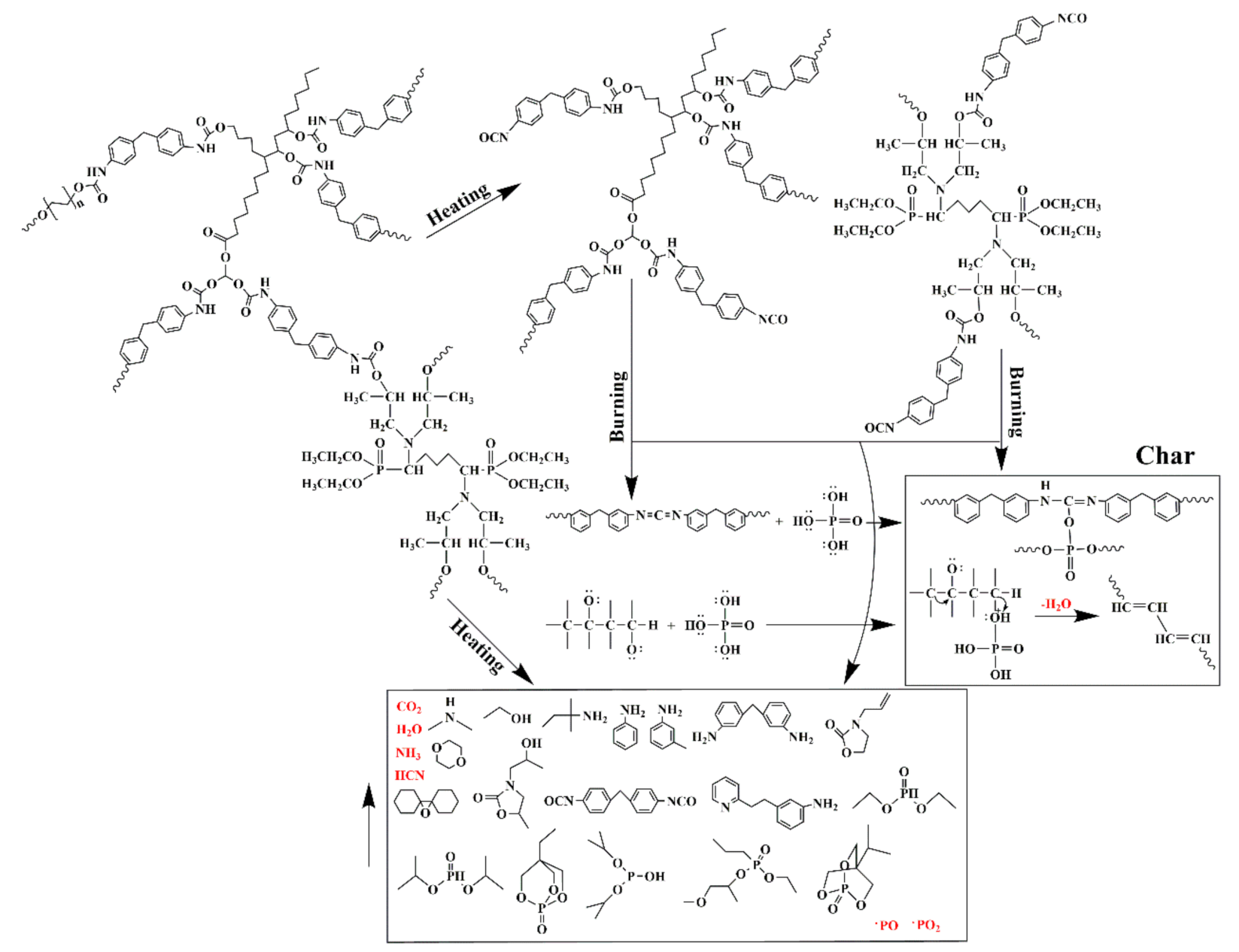

| Samples | MCOP | PEG–200 | TBPBP | Deionized Water | DMP–30 | Si–Oil | SA Powder | pMDI |
|---|---|---|---|---|---|---|---|---|
| neat RPUF | 80 | 20 | 0 | 4 | 2 | 4 | 0 | 146.79 |
| RPUF–T15 | 65 | 20 | 15 | 4 | 2 | 4 | 0 | 149.50 |
| RPUF–T30 | 50 | 20 | 30 | 4 | 2 | 4 | 0 | 152.20 |
| RPUF–T45 | 35 | 20 | 45 | 4 | 2 | 4 | 0 | 154.91 |
| RPUF–SA20 | 80 | 20 | 0 | 4 | 2 | 4 | 20 | 146.79 |
| RPUF–T45@SA20 | 35 | 20 | 45 | 4 | 2 | 4 | 20 | 154.91 |
| Sample | Density (kg/m3) | Compressive Strength (kPa) | Thermal Conductivity Coefficient W/(mK) |
|---|---|---|---|
| Neat RPUF | 36.7 ± 0.9 | 236 ± 29 | 31.67 ∗ 10−3 |
| RPUF–T15 | 37.2 ± 0.5 | 317 ± 16 | 32.13 ∗ 10−3 |
| RPUF–T30 | 37.9 ± 0.6 | 389 ± 31 | 32.79 ∗ 10−3 |
| RPUF–T45 | 38.2 ± 0.7 | 422 ± 30 | 34.65 ∗ 10−3 |
| RPUF–SA20 | 42.5 ± 1.2 | 396 ± 18 | 35.21 ∗ 10−3 |
| RPUF–T45@SA20 | 43.9 ± 1.0 | 457 ± 24 | 36.95 ∗ 10−3 |
| Samples | T5% | T50% | Rmax1/Tmax1 | Rmax2/Tmax2 | Residue (%) |
|---|---|---|---|---|---|
| °C | °C | %∙min−1/°C | %∙min−1/°C | At 700 °C | |
| neat RPUF | 249.04 | 367.04 | −7.03/307.04 | −2.88/425.04 | 16.89 |
| RPUF–T15 | 221.04 | 341.04 | −5.91/303.04 | −2.25/397.04 | 16.28 |
| RPUF–T30 | 213.04 | 359.04 | −5.07/311.04 | −2.58/389.04 | 21.14 |
| RPUF–T45 | 199.04 | 375.04 | −3.87/307.04 | −3.27/379.04 | 24.79 |
| RPUF–SA20 | 261.04 | 401.04 | −5.83/305.04 | −2.92/425.04 | 24.53 |
| RPUF–T45@SA20 | 207.04 | 385.04 | −4.01/307.04 | −2.62/383.04 | 30.90 |
| Samples | T5% | T50% | Rmax1/Tmax1 | Rmax2/Tmax2 | Residue (%) |
|---|---|---|---|---|---|
| °C | °C | %∙min−1/°C | %∙min−1/°C | At 700 °C | |
| neat RPUF | 260.48 | 452.48 | −7.29/294.48 | −7.06/502.48 | 0.47% |
| RPUF–T15 | 218.48 | 446.48 | −5.10/280.48 | −5.51/506.48 | 2.09% |
| RPUF–T30 | 212.48 | 456.48 | −4.50/278.48 | −6.01/498.48 | 4.08% |
| RPUF–T45 | 194.48 | 450.48 | −4.06/272.48 | −6.21/480.48 | 6.49% |
| RPUF–SA20 | 254.48 | 440.48 | −7.31/290.47 | −6.34/492.48 | 3.48% |
| RPUF–T45@SA20 | 210.48 | 468.48 | −3.48/274.48 | −5.16/498.48 | 10.96% |
| Sample | LOI(%) | UL–94 |
|---|---|---|
| Neat RPUF | 19.2 | N.R. |
| RPUF–T15 | 22.9 | V–0 |
| RPUF–T30 | 23.4 | V–0 |
| RPUF–T45 | 25.6 | V–0 |
| RPUF–SA20 | 20.3 | N.R. |
| RPUF–T45@SA20 | 27.7 | V–0 |
| Samples | TTI | THR | TSP | Av–EHC | Residue |
|---|---|---|---|---|---|
| s | MJ/m2 | MY+ | MJ/kg | % | |
| neat RPUF | 0 | 30.54 | 7.69 | 21.36 | 3.17 |
| RPUF–T45 | 3 | 20.67 | 5.07 | 15.75 | 9.29 |
| RPUF–SA20 | 0 | 26.05 | 5.78 | 19.69 | 4.03 |
| RPUF–T45@SA20 | 4 | 16.90 | 3.71 | 13.04 | 11.76 |
Publisher’s Note: MDPI stays neutral with regard to jurisdictional claims in published maps and institutional affiliations. |
© 2021 by the authors. Licensee MDPI, Basel, Switzerland. This article is an open access article distributed under the terms and conditions of the Creative Commons Attribution (CC BY) license (https://creativecommons.org/licenses/by/4.0/).
Share and Cite
Bo, G.; Xu, X.; Tian, X.; Wu, J.; Yan, Y. Enhancing the Fire Safety and Smoke Safety of Bio–Based Rigid Polyurethane Foam via Inserting a Reactive Flame Retardant Containing P@N and Blending Silica Aerogel Powder. Polymers 2021, 13, 2140. https://doi.org/10.3390/polym13132140
Bo G, Xu X, Tian X, Wu J, Yan Y. Enhancing the Fire Safety and Smoke Safety of Bio–Based Rigid Polyurethane Foam via Inserting a Reactive Flame Retardant Containing P@N and Blending Silica Aerogel Powder. Polymers. 2021; 13(13):2140. https://doi.org/10.3390/polym13132140
Chicago/Turabian StyleBo, Guangxu, Xiaoling Xu, Xiaoke Tian, Jiao Wu, and Yunjun Yan. 2021. "Enhancing the Fire Safety and Smoke Safety of Bio–Based Rigid Polyurethane Foam via Inserting a Reactive Flame Retardant Containing P@N and Blending Silica Aerogel Powder" Polymers 13, no. 13: 2140. https://doi.org/10.3390/polym13132140
APA StyleBo, G., Xu, X., Tian, X., Wu, J., & Yan, Y. (2021). Enhancing the Fire Safety and Smoke Safety of Bio–Based Rigid Polyurethane Foam via Inserting a Reactive Flame Retardant Containing P@N and Blending Silica Aerogel Powder. Polymers, 13(13), 2140. https://doi.org/10.3390/polym13132140






